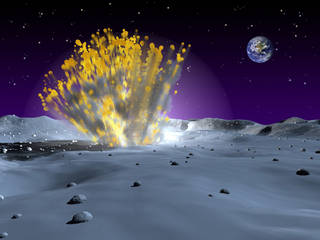MEO: Environments
Sporadic Environment | Shower Environment | Lunar Environment
Lunar Meteoroid Environment
Artist rendering of a small, powerful meteor strike on the moon
Credits: NASA
The US Space Exploration Policy calls for extended astronaut stays on the lunar surface. Unlike during the Apollo Program, when the astronauts were on the moon for just a couple of days, astronauts of the next decade will live and work on the moon for up to several months. Spacecraft, vehicles, habitats, and EVA suits must all be designed to withstand the stresses posed by the harsh lunar environment over this period of time. Meteoroids, and the ejecta produced when they create impact craters, are part of this environment.
The existing documents addressing the lunar environment were written in the Apollo era, circa 1969, when astronauts were exposed for merely hours. The Constellation Program needs new specifications concerning lunar impact ejecta so that astronauts can work for extended periods of time. The Meteoroid Environment Office (MEO) is working to determine
- The flux of large impactors on the moon
- Specifics about the production of ejecta particles created by those impacts.
Lunar Impact Monitoring
The MEO makes Earth-based observations of the dark portion of the moon in order to establish the rates and sizes of large meteoroids (greater than 500 grams or 1 pound in mass) striking the lunar surface. Observations are made about 10 nights per month, when the solar illumination of the moon is between 10 and 55 percent. Two telescopes fitted with astronomical video cameras at the Automated and Lunar and Meteor Observatory at Marshall Space Flight Center in Huntsville, Alabama are used to detect the flashes on the un-illuminated portion of the moon. The use of the second telescope rules out cosmic rays and noise; a third telescope in North Georgia helps the MEO discriminate against sun glints from orbiting debris.
To learn more, see Lunar Impact Monitoring.
Hypervelocity Impact Tests
The MEO and colleagues from Brown University have conducted a series of hypervelocity impact experiments at the NASA Ames Vertical Gun Range (AVGR) in order to better determine luminous efficiency estimates. It is necessary to determine this relationship between impact flash brightness and impactor kinetic energy so that a model of the hypervelocity ejecta from large impacts can be developed for use in lunar vehicle and spacesuit design.
Future tests are planned in order to measure ejecta properties – mass, speed, direction distributions. Hydrocode modeling will then be used to extrapolate from the test regime to the lunar regime.
To learn more, see Current Projects
























